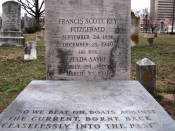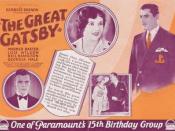The Death of America's Ideal The 1920's, although often represented as a time of irresponsibility, was more accurately a decade of bingeing on hopes, dreams, and aspirations. The illusionary ambitions of Americans, however, led them to many a downfall. The American Dream varied from person to person, but ultimately, its quest resulted in a personal dissolution. The fallacies of the American Dream are evident throughout F. Scott Fitzgerald's The Great Gatsby.
Jay Gatsby, the novel's protagonist, begins as a generic success story of the 1920's. He invented a more appealing identity for himself as a means of rising above his Midwestern farming heritage, "...and to this conception he was faithful to the end." Once a fisherman named James Gatz, the essence of Jay Gatsby "sprang from his Platonic conception of himself'"(104). He meets one influential man who guides him to the better fork in the road of life, encouraging Gatsby to make money by any means possible.
Gatsby involves himself in unlawful activities, and prospers in turn. But debatably, his thirst for the Dream had not yet been quenched. He had money, he had power. He "was overwhelmingly aware of the youth and mystery that wealth imprisons and preserves." He wanted happiness. His dream was that money and power could buy him happiness. Obviously, he didn't understand society, and that was his downfall.
But he was a believer, and he kept to the idea that he could be happy now that he was "somebody." His true happiness would only come via Daisy, his love from long ago. His dream was kindled nightly, when the green light at the end of her dock was turned on. This was his light at the end of the tunnel, symbolizing the last stage in his plight for gratification. He believed that "...if he could once again return to a certain place and go over it all slowly, he could find out what that thing was..." This castle in the air ultimately proved to be an inanity. Instead of a light signaling the end of the tunnel, it was the light on a train headed his way.
Gatsby's character best portrayed the fallout of the American Dream in The Great Gatsby. Gatsby's lifestyle, social status, and even his name changed. But his dream remained the same: an easy, wealthy life with Daisy. This dream brought him to his doom, thus depicting the "withering of the American Dream." Because he had known the feeling of both wealth and poverty, he strived to be "safe and proud above the hot struggles of the poor." However, he sank, and his doom came because of "...what foul dust floated in the wake of his dreams..."





